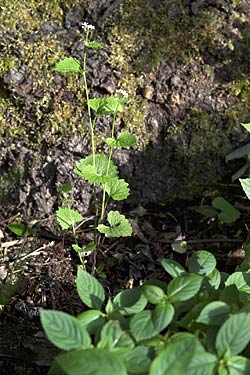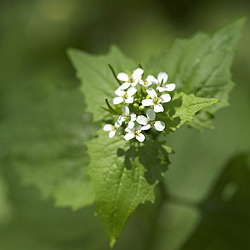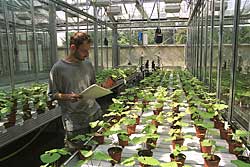Press release May 24th, 2006
Invasive species suppress the growth of native trees
Is Canada’s national symbol dying out because of a European herb?
Halle/Saale. Exotic herbs can have a serious effect on the growth of native tree seedlings, according to a team of US, Canadian and German researchers writing in the May issue of PLoS Biology, a respected journal published by the Public Library of Science. During research into garlic mustard (Alliaria petiolata) the researchers came across a novel mechanism that slows down tree propagation. The plant secretes toxic substances that damage fungi in the soil. This prevents the young tree seedlings from taking root, thereby forcing out established tree species. The UFZ Centre for Environmental Research Leipzig-Halle was involved in the research. The study caused a stir in Canada because the indigenous tree species affected there include the maple, the leaf of which is Canada’s national symbol.

Garlic mustard (Alliaria petiolata) secretes toxic substances that damage fungi in the soil. This prevents
the young tree seedlings from taking root, thereby forcing out established tree species.
Foto: André Künzelmann/UFZ

Blossoms of Garlic mustard (Alliaria petiolata).
Foto: André Künzelmann/UFZ

Dr. Daniel Prati from the UFZ at his scientific research in the greenhoause.
Foto: UFZ
In the experiments, sugar maple, red maple and white ash showed significantly less colonisation by soil fungi. The colonisation of tree roots by soil fungi (mycorrhizas), is however an important step in the establishment of young trees, since the fungi help the trees take up nutrients from the soil. Comparisons with other species of tree showed that garlic mustard evidently affects only hardwood trees. The study was a collaborative project between Havard, Montana and Purdue Universities in the US, Canada’s University of Guelph and the UFZ Centre for Environmental Research Leipzig-Halle. Botanists at the UFZ have for years been studying life communities from various plants and animals – so-called biocoenoses. “We had actually been examining garlic mustard because we wanted to study insect infestation on it in order to develop biological pest control methods”, explains Dr. Daniel Prati of the UFZ. “So we were all the more surprised to come across a novel mechanism which could be an important component in nature’s complicated displacement processes.”
The inconspicuous garlic mustard was introduced to North America from Europe as a herb around 1860. It is now regarded there as a species that reproduces rapidly and is spreading. So-called neophytes (‘new plants’) can unbalance existing ecosystems. The damage caused by neophytes to US agriculture alone is estimated at over 27 billion dollars per year. For this reason, the release of foreign species into the wild now requires authorisation in Germany. Garlic mustard is originally a plant of deciduous forests, but it is also found on uncultivated roadsides and in urban areas. This inconspicuous plant grows up to a metre in height. Its common name comes from its intense garlic flavour. Alliaria petiolata is used both as a herb and for treating bronchitis and eczema because it contains a glycosinolate.
The interdependence of plants and soil fungi is one of the topics being addressed by biologists at the 2006 international PopBio conference. The conference takes
place from 24 to 27 May in Halle/Saale and is being organised by the Ecological Society of Germany, Austria and Switzerland (GfÖ), the Martin Luther University
Halle and the UFZ.
Tilo Arnhold
More information:
Original publication:
biology.plosjournals.org
Background information about the Public Library of Science/ Open Acsess:
de.wikipedia.org/wiki/Public_Library_of_Science
More information aboiut Garlic mustard:
de.wikipedia.org/wiki/Alliaria
Conference PopBio (24.-27.5.06 in Halle/Saale):
Tagung PopBio
More scientific information:
Dr. Daniel Prati
Department of Community Ecology
Helmholtz Centre for Environmental Research – UFZ
phone ++49 345 558 5305
www.ufz.de/index.php?en=903
or
Dr. Stefan Klotz
Leiter der Biozönoseforschung am Umweltforschungszentrum Leipzig-Halle (UFZ)
phone +49 345 558-5301
or
Doris Böhme / Tilo Arnhold,
Public Relations of Helmholtz Centre for Environmental Research – UFZ
Phone: +49-341-235-2278
E-mail: presse@ufz.de
